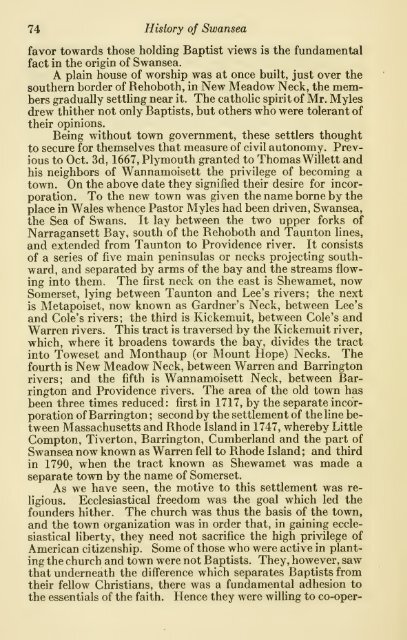History of Swansea, Massachusetts, 1667-1917; - citizen hylbom blog
History of Swansea, Massachusetts, 1667-1917; - citizen hylbom blog
History of Swansea, Massachusetts, 1667-1917; - citizen hylbom blog
You also want an ePaper? Increase the reach of your titles
YUMPU automatically turns print PDFs into web optimized ePapers that Google loves.
74 <strong>History</strong> <strong>of</strong> <strong>Swansea</strong><br />
favor towards those holding Baptist views is the fundamental<br />
fact in the origin <strong>of</strong> <strong>Swansea</strong>.<br />
A plain house <strong>of</strong> worship was at once built, just over the<br />
southern border <strong>of</strong> Rehoboth, in New Meadow Neck, the members<br />
gradually settling near it. The catholic spirit <strong>of</strong> Mr. Myles<br />
drew thither not only Baptists, but others who were tolerant <strong>of</strong><br />
their opinions.<br />
Being without town government, these settlers thought<br />
to secure for themselves that measure <strong>of</strong> civil autonomy. Previous<br />
to Oct. 3d, <strong>1667</strong>, Plymouth granted to Thomas Willett and<br />
his neighbors <strong>of</strong> Wannamoisett the privilege <strong>of</strong> becoming a<br />
town. On the above date they signified their desire for incorporation.<br />
To the new town was given the name borne by the<br />
place in Wales whence Pastor Myles had been driven, <strong>Swansea</strong>,<br />
the Sea <strong>of</strong> Swans. It lay between the two upper forks <strong>of</strong><br />
Narragansett Bay, south <strong>of</strong> the Rehoboth and Taunton lines,<br />
and extended from Taunton to Providence river. It consists<br />
<strong>of</strong> a series <strong>of</strong> five main peninsulas or necks projecting southward,<br />
and separated by arms <strong>of</strong> the bay and the streams flowing<br />
into them. The first neck on the east is Shewamet, now<br />
Somerset, lying between Taunton and Lee's rivers; the next<br />
is Metapoiset, now known as Gardner's Neck, between Lee's<br />
and Cole's rivers; the third is Kickemuit, between Cole's and<br />
Warren rivers. This tract is traversed by the Kickemuit river,<br />
which, where it broadens towards the bay, divides the tract<br />
into Toweset and Monthaup (or Mount Hope) Necks. The<br />
fourth is New Meadow Neck, between Warren and Barrington<br />
rivers; and the fifth is Wannamoisett Neck, between Barrington<br />
and Providence rivers. The area <strong>of</strong> the old town has<br />
been three times reduced: first in 1717, by the separate incorporation<br />
<strong>of</strong> Barrington ; second by the settlement <strong>of</strong> the line between<br />
<strong>Massachusetts</strong> and Rhode Island in 1747, whereby Little<br />
Compton, Tiverton, Barrington, Cumberland and the part <strong>of</strong><br />
<strong>Swansea</strong> now known as Warren fell to Rhode Island; and third<br />
in 1790, when the tract known as Shewamet was made a<br />
separate town by the name <strong>of</strong> Somerset.<br />
As we have seen, the motive to this settlement was religious.<br />
Ecclesiastical freedom was the goal which led the<br />
founders hither. The church was thus the basis <strong>of</strong> the town,<br />
and the town organization was in order that, in gaining ecclesiastical<br />
liberty, they need not sacrifice the high privilege <strong>of</strong><br />
American <strong>citizen</strong>ship. Some <strong>of</strong> those who were active in planting<br />
the church and town were not Baptists. They, however, saw<br />
that underneath the difference which separates Baptists from<br />
their fellow Christians, there was a fundamental adhesion to<br />
the essentials <strong>of</strong> the faith. Hence they were willing to co-oper-

















